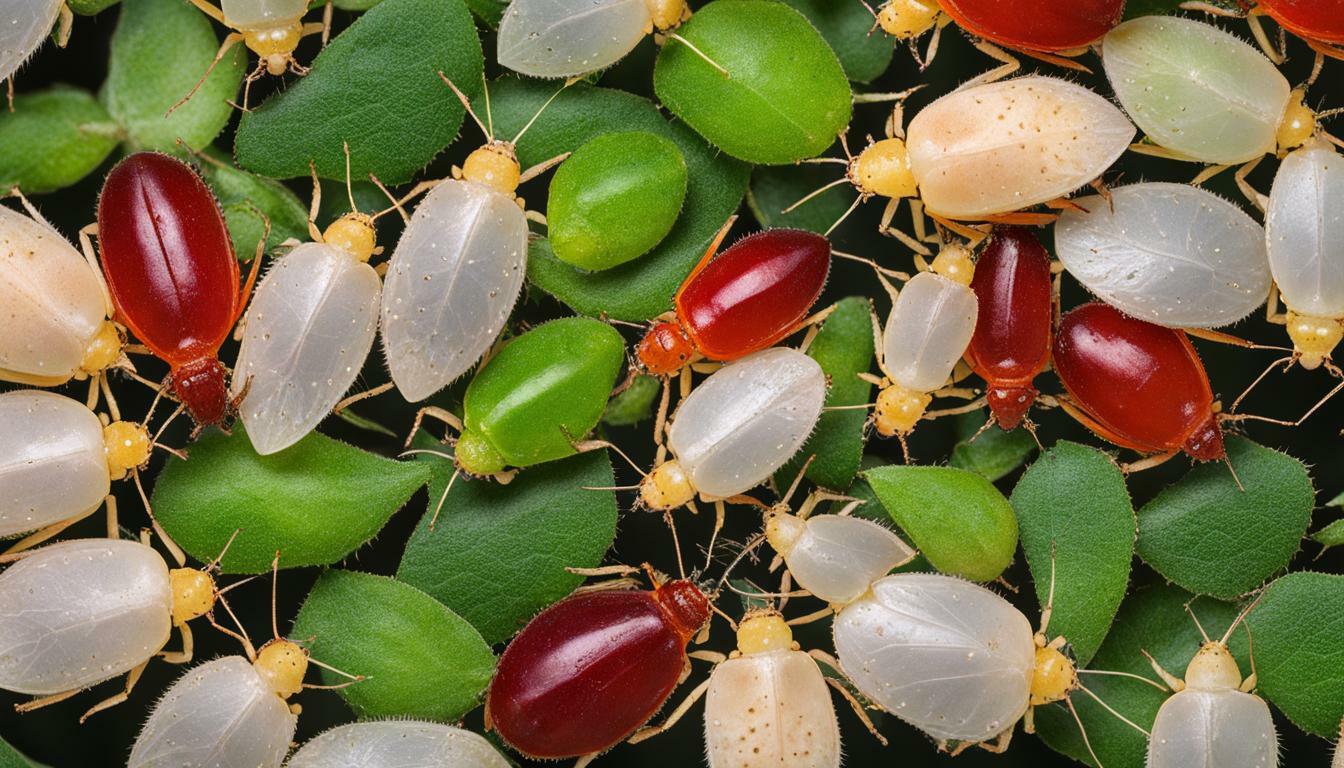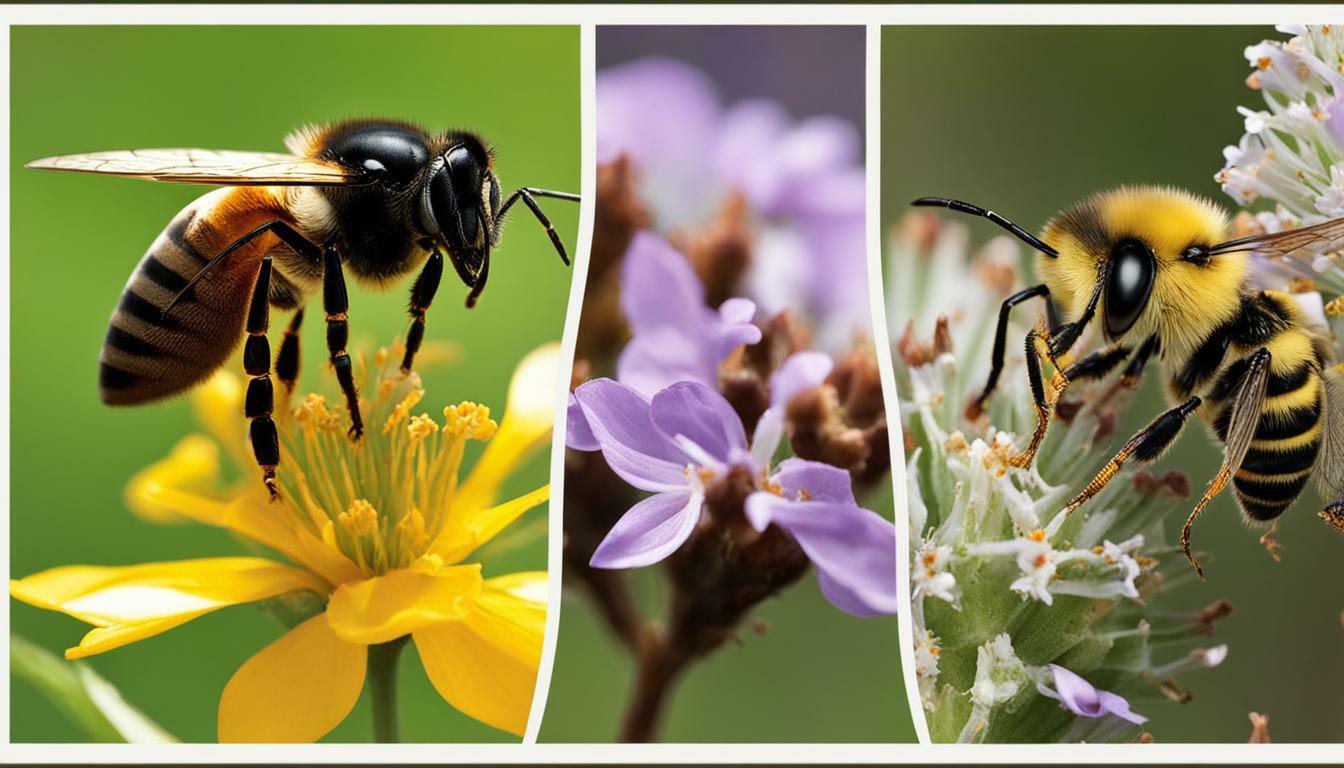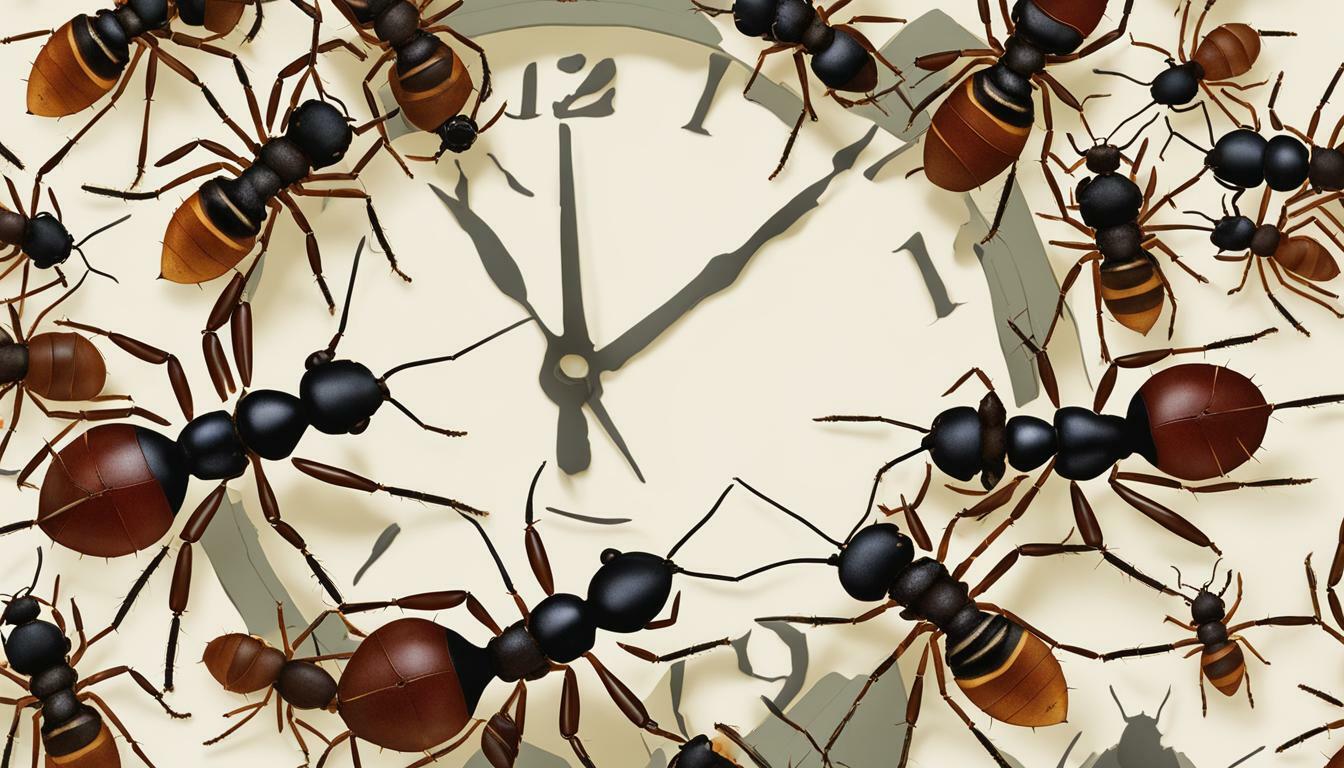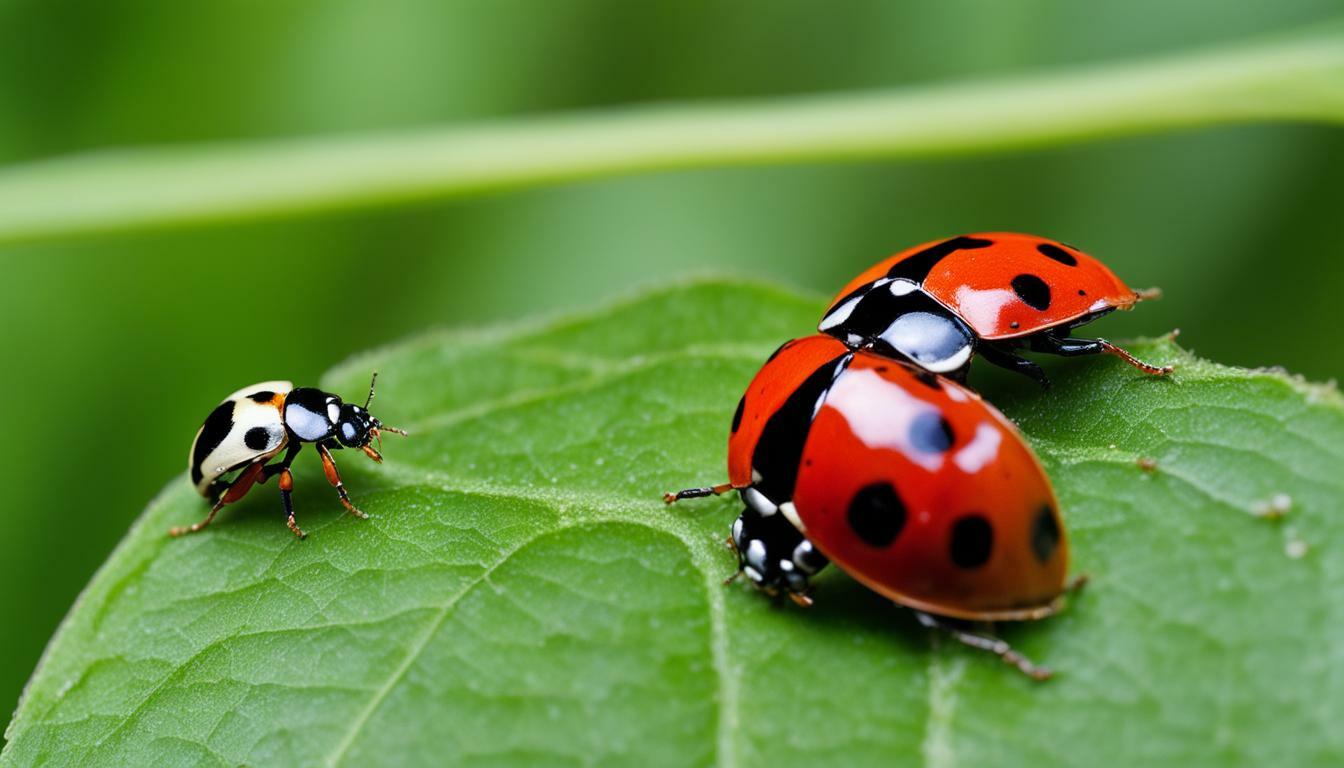As a gardener, dealing with pests is an inevitable part of the job. Two common pests that often wreak havoc on plants are aphids and whiteflies. While they may seem alike at first glance, there are several distinguishing characteristics that set them apart.
In this section, we will explore the key differences between aphids and whiteflies, helping you identify these insects and effectively deal with them in your garden. We’ll delve into their physical appearance, feeding habits, life cycles, and the damage they can cause to plants. By the end of this section, you’ll have a comprehensive understanding of these common garden pests.
Key Takeaways:
- Distinguishing characteristics exist between aphids and whiteflies, two common garden pests
- Understanding the differences between aphids and whiteflies can aid in pest management
- Physical appearance, feeding habits, life cycles, and plant damage are key factors for identifying and controlling these pests
What Are Aphids?
Aphids are small, sap-sucking insects that are commonly found in gardens and on crops. They range in size from 1 to 10 millimeters and come in a variety of colors, including green, yellow, black, and brown. They have a pear-shaped body with long antennae and two short tubes called cornicles on their back end.
One of the reasons aphids are so damaging is because they reproduce quickly. Female aphids are capable of producing up to 12 offspring per day without mating, which can lead to infestations in a short amount of time.
Aphids use their piercing-sucking mouthparts to feed on the sap of plants, which can cause stunted growth, yellowing leaves, and distorted flowers or fruit. They also excrete a sticky substance called honeydew, which can attract other pests like ants and mold.
Physical Characteristics of Aphids
| Physical Characteristic | Aphids |
|---|---|
| Size | 1-10 mm |
| Color | Green, yellow, black, brown |
| Body shape | Pear-shaped |
| Antennae | Long |
| Cornicles | Two short tubes on back end |
Aphids are often confused with other insects, such as whiteflies, due to their small size and similar feeding behavior. However, their physical characteristics, particularly their pear-shaped body and cornicles, help distinguish them from other pests.
Aphids vs Whiteflies: Differences and Similarities
“While aphids and whiteflies both feed on plant sap, they have distinct physical differences and behavior. Aphids have a pear-shaped body with long antennae and two short tubes called cornicles on their back end. Whiteflies, on the other hand, have a more oval-shaped body, with white wings and a cloud of white dust that appears when they are disturbed.”
Overall, aphids are a common and destructive pest that can cause significant damage to plants. By understanding their physical characteristics, feeding habits, and lifecycle, you can take steps to prevent and control infestations.
What Are Whiteflies?
Whiteflies are small, winged insects that belong to the family Aleyrodidae. Like aphids, they are sap-sucking pests that can cause significant damage to plants. However, there are some key differences between whiteflies and aphids.
One major difference is in their physical appearance. While aphids have a more elongated body shape and can be various colors, whiteflies are typically small, white or yellowish insects with a distinctive powdery appearance. They also have wings that are held parallel to their body when at rest, whereas aphids have wings that are typically folded over their back.
Another difference is in their lifecycle. Whiteflies have a similar lifecycle to aphids in that they undergo a complete metamorphosis, with egg, larval, pupal, and adult stages. However, whiteflies tend to produce fewer generations per year than aphids, typically producing two to three generations in a season depending on the climate.
Despite their differences, whiteflies can cause similar damage to plants as aphids can. They can weaken plants, stunt growth, and transmit plant diseases. The signs of whitefly infestation are similar to those of aphids, including the presence of sticky honeydew, black sooty mold, and yellowing or wilting leaves.
Similarities and Distinctions Between Aphids and Whiteflies
While there are some clear differences between aphids and whiteflies, there are also some similarities and overlapping characteristics to be aware of. Both pests feed on plant sap, excrete honeydew, and can transmit plant viruses. They also share some natural enemies, such as ladybugs and lacewings, that can help control infestations.
However, there are some key distinctions to keep in mind as well. For example, whiteflies tend to be more difficult to control than aphids due to their ability to disperse quickly and reproduce rapidly.
In summary, while there are similarities and distinctions between aphids and whiteflies, it is important to understand their unique characteristics in order to effectively manage infestations and protect your plants.
Physical Differences Between Aphids and Whiteflies
Aphids and whiteflies are two common garden pests that can be challenging to identify. However, there are several key physical differences between them that can help distinguish one from the other.
Firstly, aphids are generally smaller than whiteflies, measuring around 1-10 mm in length. In contrast, whiteflies are slightly larger, measuring around 1-3 mm in length. This size difference can be useful in identifying which pest you’re dealing with.
Secondly, aphids have soft and plump bodies that range in color from green to brown, yellow, and black. They have two pairs of wings, but not all species have wings or use them for flying. Whiteflies, on the other hand, have flat and triangular-shaped bodies that are typically white or light yellow. They also have distinctive white wings that are held in a tent-like formation over their bodies when they’re at rest.
Another distinguishing feature between aphids and whiteflies is their antennae. Aphids have curved antennae that are shorter than their bodies. Whiteflies, on the other hand, have straight antennae that are longer than their bodies.
Lastly, the feeding behavior of aphids and whiteflies can also differ. Aphids are known for piercing leaves and stems with their mouthparts to suck out the sap of the plant. In contrast, whiteflies feed by using their piercing-sucking mouthparts to extract plant sap while excreting honeydew on the leaves, which can attract ants and cause sooty mold.
| Physical Characteristics | Aphids | Whiteflies |
|---|---|---|
| Size | 1-10 mm | 1-3 mm |
| Body Shape | Soft and Plump | Flat and Triangular |
| Body Color | Green, Brown, Yellow, or Black | White or Light Yellow |
| Wings | Two pairs, not all species use them for flying | Distinctive white wings held tent-like over their bodies |
| Antennae | Curved and shorter than body | Straight and longer than body |
| Feeding Habits | Pierce leaves and stems to suck sap | Use piercing-sucking mouthparts to extract sap and excrete honeydew on leaves |
Understanding the physical differences between aphids and whiteflies is essential for identifying which pest you have. Once you know which pest you’re dealing with, you can take effective measures to control or eradicate them.
Feeding Habits and Plant Damage
Aphids and whiteflies are similar in their feeding habits, but they cause different types of damage to plants. Aphids use their sharp, straw-like mouthparts to pierce plant tissues and suck out the sap. This results in wilting, stunted growth, yellowing, and curling of leaves. They also secrete a sticky, sweet substance called honeydew, which attracts ants and promotes the growth of sooty mold on leaves.
Whiteflies, on the other hand, feed on plant sap by puncturing the leaves and stems, causing them to turn yellow and wilt. They also excrete honeydew, which attracts ants and promotes the growth of sooty mold. In addition, whiteflies are known to transmit viruses to plants, which can lead to severe damage and reduced crop yields.
To identify the differences in plant damage caused by these pests, carefully examine the affected plants for signs of infestation. Aphids tend to gather on the undersides of leaves, while whiteflies can be found on both the upper and lower surfaces of leaves. If you spot any honeydew or sooty mold, it’s likely that aphids or whiteflies are present.
It’s important to take measures to control aphids and whiteflies before they cause irreversible damage to your plants. This may involve using natural predators, such as ladybugs and lacewings, or applying insecticidal soap or neem oil to affected plants. By identifying the differences in feeding habits and plant damage, you can take steps to effectively manage aphids and whiteflies in your garden.
Lifecycle and Reproduction
Both aphids and whiteflies are known for their rapid reproductive abilities, making it crucial to understand their lifecycles to effectively control their populations.
Aphids have a complex lifecycle, which includes both sexual and asexual reproduction. Females can give birth to live young without mating, allowing for a speedy population increase. However, sexual reproduction also occurs in the fall, leading to the production of overwintering eggs, which hatch in the spring.
Whiteflies, on the other hand, have a simpler lifecycle that includes only sexual reproduction. Females lay their eggs on the undersides of plant leaves, and the young nymphs emerge to feed on the plants. The entire lifecycle can be completed in as little as three weeks, allowing for numerous generations per year.
Overall, while both aphids and whiteflies have the potential to reproduce quickly, the methods of reproduction differ. Aphids can reproduce both sexually and asexually, while whiteflies reproduce solely through sexual reproduction. Understanding these differences can aid in implementing effective control measures.
Conclusion
In conclusion, understanding the difference between aphids and whiteflies is essential for effective pest control in your garden. While both pests can cause significant damage to plants, they have distinct characteristics and behaviors that require different approaches for control.
Aphids are small, pear-shaped insects that feed on plant sap and can reproduce rapidly, leading to widespread infestations. They can cause stunted growth, curling leaves, and the spread of viral diseases among plants.
Whiteflies, on the other hand, are tiny, winged insects that feed on plant sap and lay their eggs on the underside of leaves. They can cause yellowing and wilting of leaves, as well as the spread of viral diseases.
By identifying the distinguishing characteristics of aphids and whiteflies, such as their physical appearance, feeding habits, and lifecycle, you can implement targeted control measures. Some effective methods for control include natural predators, insecticidal soap, and reflective mulch.
With this knowledge in hand, you can safeguard your plants from infestations and keep your garden thriving. Remember to regularly monitor your plants for signs of aphids and whiteflies and take action at the first sign of an infestation. Become a green thumb guru and protect your garden from these pesky pests!
FAQ
Q: What are the main differences between aphids and whiteflies?
A: Aphids and whiteflies have different physical characteristics, feeding habits, and life cycles. Understanding these differences is important for effective pest management.
Q: What do aphids look like?
A: Aphids are small, soft-bodied insects that come in various colors, including green, black, brown, and red. They have long antennae and may or may not have wings.
Q: What do whiteflies look like?
A: Whiteflies are tiny, winged insects that are usually white or yellow in color. They have a powdery appearance and can be easily identified by their distinct jumping behavior when disturbed.
Q: How do aphids and whiteflies feed?
A: Aphids feed by piercing plant tissue and sucking out the sap. Whiteflies feed by sucking plant sap directly from the leaves.
Q: What kind of damage do aphids and whiteflies cause to plants?
A: Aphids can cause stunted growth, distorted leaves, and the transmission of plant diseases. Whiteflies can cause leaf yellowing, reduced plant vigor, and the secretion of sticky honeydew.
Q: What is the life cycle of aphids?
A: Aphids have a complex life cycle that involves both sexual and asexual reproduction. They can reproduce rapidly, with each generation producing live offspring without the need for mating.
Q: What is the life cycle of whiteflies?
A: Whiteflies go through a four-stage life cycle: egg, nymph, pupa, and adult. They lay their eggs on the undersides of leaves, and the nymphs emerge and feed on the plant sap before maturing into adults.
 Skip to main content
Skip to main content


